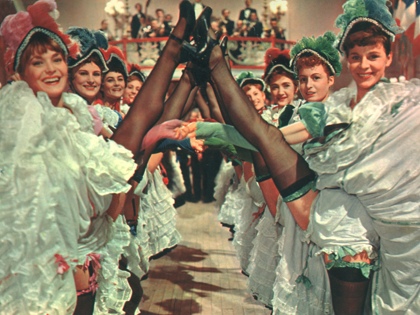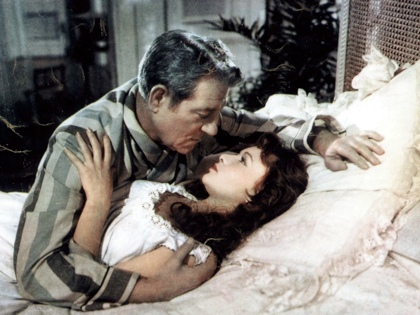Review / From the archives
French Cancan

Jean Renoir’s triumphant return to la comedie Parisien makes poetry of showmanship, as Catherine de la Roche wrote in our Autumn 1955 issue
French Cancan
France 1955
Director: Jean Renoir
With Jean Gabin, Françoise Arnoul, Maria Félix, Gianni Esposito
104 mins | Cert PG
A slowly receding view of the illuminated Moulin Rouge, as if returning to its fabulous past, disappears; echoes of an exultant triumph within gradually fade; French Cancan has reached its fittingly dream-like end. The story of some legendary show people and of the great show they put on has been well told, but the overwhelming impression left by this picture is of a perfect, an enchanted evocation of the very spirit of showmanship. In La Grande Illusion and Le Regle du Jeu, in The Southerner and The River, Jean Renoir, magnificently at his best, developed large themes. With French Cancan he has renewed his style, creating a masterpiece on a light theme, in which his wise and humorous perception is combined with new brilliance and charm. A charm that is very personal, for the inspiration of this film seems to be the fascinating charm for him of show folk and their world. And how marvellously he has caught it!
Described on its gay, poster-style credit titles as a musical comedy, the film is actually composed in colour sequences rather than musical ones. It opens flamboyantly with Maria Felix as the notorious Belle Abbesse doing an oriental dance in a fashionable variety hall, full of rich hues, black and white predominating. In the cheap dance hall where Jean Gabin, as an impresario with a flair for developing young talent, meets Françoise Arnoul, the pretty laundress Nini whom he later transforms into a cancan star, the colours are lighter, brought here and there into relief by ink blue, and the range is simpler. One image of a grave little wallflower dressed in green introduces a contrasting shade. Similarly, two indescribably funny scenes in which the arch-seductress Belle Abbesse receives her admirers reclining on an enormous crimson couch, serve as vivid counterpoints in the film’s general composition. Particularly successful is the sequence gradually made up in pinks: Prince Charming comes to Montmartre with some roses for Nini; they sit under a nearby tree, screened by a fluttering line of washing, and he declares his love; his roses, her dress, the tree blossoms, but nothing else, are in delicate pinks, matching the exquisite delicacy of the scene. Art director Max Douy and lighting cameraman Michel Kelber have excelled themselves.
The story is carried swiftly forward by the excitement of an idea – the impresario’s dual idea of building the Moulin Rouge as a centre of “high life for small purses” and of opening it with a revival of the long-forgotten cancan. Training, construction and some incidental destruction proceed apace. Taught by a splendid veteran, Lydia Jeanson, a troupe of girls learn what it takes in grit and toil to do splits and high kicks in true cancan style. At the ceremonial laying of the Moulin Rouge foundations, La Belle Abbesse, suspecting Nini of being a rival, starts a fight: counter-attacks follow attacks with a mad logic that makes nonsense of fighting itself and of everything save the wit of the scene – which ends as the band forlornly strikes up a dignified tune. Intrigues are overcome, backers, placated, and all the time the panorama of Montmartre is kept alive as the quartier to which the show people belong together with the chattering washerwomen, the blasé pickpockets, the idealistic young baker. One magical evening Nini, who will never leave this quarter, takes the prince (Giani Esposito), who can never belong to it, on a grand tour of the famous night spots, all different, all part of the variety tradition she has adopted.

By the time the story reaches the opening gala of the Moulin Rouge, the building itself, glittering with brave ostentation, stands as a symbol of this tradition. The red and pink hall, filled with all kinds of people from Montmartre and far beyond, including some Russian sailors on shore leave from Brest who are made graciously welcome, is a mass of colour and excitement. And yet it looks subdued compared with the brilliant figures on and behind the stage and with the fire that animates them. The whistling clown (Pierre Olaf) renders a melody full of pathos; Anna Amendola follows with a haunting street song; and, after one last explosion of jealousy backstage, which all but wrecks the show, the cancan girls burst into the hall from every direction, leaping over tables, involving the public in the wild exuberance of their performance. Alone behind the scenes Jean Gabin listens; shouts of delight greet each volley of high kicks as the girls dance forward, flourishing their lace petticoats, row upon row and over again; the clamour increases, and, smiling, he stays there to enjoy the sounds of success.
In French Cancan, then, Jean Renoir has achieved a wonderful blend of stylisation and reality, of poetic expression and robust showmanship. Several sequences – in the noisy market, for instance, or the romantic episodes – are pure picture-book fairyland in all save the natural simplicity of the acting, thanks to which the characters always remain real. In the comedy scenes, on the other hand, like the foundation ceremony or the rendezvous in Maria Felix’s boudoir, the background is realistic and the action, both individually and as a whole, stylised, but performed with such sincere gusto that credibility is never interrupted. Unlike Le Carosse d’Or, in which Jean Renoir had already presented a larger-than-life story of show people, but without achieving unity of style, this film is of a piece. It repays study, as much for the original use of each of the cinema’s component elements – acting, colour, sound, design – as for the success with which these and the stylistic variations have been integrated. Above all, it is a picture to see, without a critics’s notebook, as a rare pleasure.
— Catherine de la Roche, Sight & Sound, Autumn 1955
French Cancan is re-released from 5 August 2011 at the BFI Southbank
See also
Our Flickr gallery of French Cancan set designs, on-set photos and international posters
A love-hate relationship: Ginette Vincendeau on Potiche and relations between French cinema and boulevard theatre (July 2011)
The River reviewed by Bryony Dixon (November 2004)
Moulin Rouge reviewed by José Arroyo (September 2001)
Divining the real: Peter Matthews argues for the rehabilitation of André Bazin (August 1999)
Boudu Saved from Drowning reviewed by Tom Milne (Monthly Film Bulletin, November 1965)
